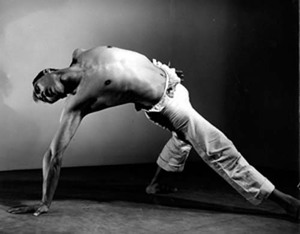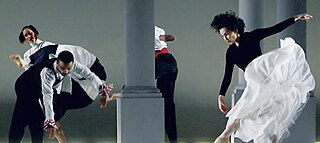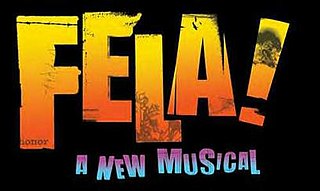Career
Early years
During his 1971 freshman year at Binghamton, Jones met and fell in love with Arnie Zane, a 1970 graduate of the university who was living in the area honing his skills as a photographer. The personal connection they forged evolved into a personal and professional relationship that lasted until Zane's death from AIDS in 1988 [7] : 17 About a year after meeting, the pair spent a year in Amsterdam, Netherlands. On returning, Jones and Zane connected with dancer Lois Welk, who introduced them to contact improvisation, an emerging dance technique popularized by Steve Paxton that emphasizes intertwining partnering and shifts of weight and balance between partners. [8] : 116 With Welk and another dancer, Jill Becker, they formed American Dance Asylum (ADA) in 1974. ADA was organized as a collective and performed nationally and internationally while also offering classes and presenting performances at its space in Binghamton. While the members of ADA generally choreographed their own works, they used a collaborative development process in which each member informed the activities of the others. [7] : 59 Jones created a number of solo pieces during this period and was invited to present in New York City beginning in 1976, performing at The Kitchen, Dance Theater Workshop, and the Clark Center, among other venues. [8] : 138
Jones's works during this period, such as Floating the Tongue (1979) and Everybody Works/All Beasts Count (1975), combined his elegant style of movement with spoken passages that explored and improvised on his reactions and memories evoked by the dancing, ranging from episodes in his life to digressions on social issues. [8] : 134–36 Dance historian Susan Foster has characterized these works as using "the resonances between movement and speech to show the very mechanics of meaning-making and to deepen viewers' perceptions of the number of ways a movement can mean." [9] : 198
In 1979, Jones and Zane felt that their collaboration with Welk and Becker had reached its conclusion. They were also interested in living in an area more supportive of both the art they were making and their identity as an interracial gay couple. They moved to the New York area in late 1979, settling in Rockland County, where they soon bought a house. [8] : 133–34
The physical contrast between Jones (tall, Black, gracefully athletic) and Zane (short, White, sharply moving), together with contact improvisation techniques of intertwining and lifting formed the basis of many of the pair's dances during this period. The works they created together fused Jones's interest in movement and speech with Zane's visual sensibility rooted in his work as a photographer. [10] : 66 Their duets featured film projections, stop-and-go movement and framing drawn from still photography, singing, and spoken dialogue. [11] : 429 At the forefront of their works was their political and social focus, and the unusual—for the period—pairing of two male dancers and a frank acknowledgement of their personal relationship. [12] A trilogy of duets the pair created during this time, consisting of Blauvelt Mountain (1980), Monkey Run Road (1979) and Valley Cottage (1981), firmly established their reputations as important new choreographers. [7] : 62
Bill T. Jones/Arnie Zane Dance Company
From the mid 1970’s until 1981, Jones and his partner, Arnie Zane, toured the world dancing sexually provocative duets. Jones had also danced solos. In 1982, the pair formed the Bill T. Jones / Arnie Zane Dance Company, recruiting a troupe of individualistic and nontraditional performers who represented different body sizes, shapes, and colors.” “Jones, a choreographic provocateur, presents his ideas about identity, art, race, sexuality, nudity, power, censorship, homophobia, and AIDS-as-chemical-warfare with a streetwise, in-your-face attitude.” Works such as Last Supper at Uncle Tom’s Cabin/The Promised Land (1990) and Still/Here are some of his most thought-provoking works. [13]
Last Supper at Uncle Tom's Cabin
The work Last Supper at Uncle Tom's Cabin/The Promised Land is about how people are different racially, sexually, and other ways. It is about working through these differences to reach a better place. It is about being strong but still yearning for acceptance and tolerance. Jones's company is made up of a diverse group of individuals, each with their own unique contribution. The piece is also about Jones conflict with faith. Jones grew up in a religious home with a devout mother but he questions how Jesus allowed the cruelties of slavery to happen. Jones also questions the cruelty and death caused by AIDS and how that meshes with having faith. Jones discusses how slave women were strong and had muscles as strong as men. He says his mother is a very strong woman. Jones believes people need to be strong but also tolerant. In the act "Eliza on the Ice", four very different women play the role of Eliza. But the fifth Eliza addresses the issue of sexuality. This Eliza is a man in a miniskirt and white high heels. Some gay men are caught in a type of slavery since they are not clearly masculine or feminine. They do not know where they belong. This piece is about the people who are performing it. Jones yearns for a state where people are totally accepting of each other. Nudity is an important aspect of this acceptance. The dancers are all very different physically from one another. The first nude seen is when Eliza is sexually molested. Here nudity is used to degrade women and use power over them. But the dance transforms nudity from something terrible to something beautiful at the end where all the different bodies find acceptance. [14]
Still/Here controversy
Although Last Supper at Uncle Tom's Cabin/The Promised Land was one of Jones's largest and most political productions, the 1995 New York premiere of Still/Here led to a great deal of controversy and discussion. Still/Here is about dying, based on videotaped statements of people suffering from deadly diseases such as AIDS and cancer. [15] It features a video score by artist Gretchen Bender based on excerpts from interviews with people who had received such diagnoses, together with a commissioned musical score, spoken text and movement. [16] This work raises the question of whether art should be political. Most critical comments were favorable for the production, especially since many dancers were affected by AIDS. [15] Still/Here was well received on its 1994 international tour. Newsweek called it "a work so original and profound that its place among the landmarks of 20th-century dance seems ensured." [17] However, Arlene Croce, dance critic for The New Yorker , wrote in her article "Discussing the Undiscussable" a sharp negative critic of artists who present themselves as victims. Croce was so disgusted by "victim art" that she refused to see the production. Croce blamed politics for the sensation of victim art. "The arts bureaucracy in this country, which includes government and private-funding agencies, has in recent years demonstrated a blatant bias for utilitarian art-art that justifies the bureaucracy's existence by being socially useful." [15]
Croce's essay generated considerable discussion, pro and con. The next issue of the New Yorker (January 30, 1995) featured four pages of letters about the article from prominent cultural figures such as Robert Brustein, bell hooks, Hilton Kramer, Camille Paglia and Tony Kushner. In dissent, critic bell hooks observed: "To write so contemptuously about a work one has not seen is an awesome flaunting of privilege—a testimony to the reality that there is no marginalized group or individual powerful enough to silence or suppress reactionary voices. Ms. Croce's article is not courageous or daring, precisely because it merely mirrors the ruling political mood of our time." [18] Many other liberals, such as Richard Goldstein from the Village Voice also sharply criticized Croce. Deborah Jowitt, a dance critic for the Village Voice wrote "It's ironic…that Croce, so firmly opposed to the politicization of art, chose to turn her own critical essay into a political statement by declining to see the work at hand.” Yet other critics chose not to see this work either because they have been unimpressed with Jones choreography in his past productions or because works based on racism, sexism, AIDS have become predictable. Either way, Croce's article is successful at bringing attention to the politicization of the American Arts. Croce argues for "the autonomy of art" or "art for art's sake". However, “opposing the politicization of art is now taken to be a political act”. . [15] . The debate broadened to the national press. Author Joyce Carol Oates noted in The New York Times: "As with the Mapplethorpe obscenity trial of several years ago, the article has raised crucial questions about esthetics and morality, about the role of politics in art and about the role of the professional critic in assessing art that integrates 'real' people and events in an esthetic framework." [19] The coverage brought Jones to wider attention. In 2016, Newsweek wrote, "Jones is probably best known outside of dance circles for his 1994 work Still/Here." [20]
Other collaborators
Creating more than 100 works for his own company, Jones has also choreographed for Alvin Ailey American Dance Theater, AXIS Dance Company, Boston Ballet, Lyon Opera Ballet, Berlin Opera Ballet and Diversions Dance Company, among others. In 1995, Jones directed and performed in a collaborative work with Toni Morrison and Max Roach, Degga, at Alice Tully Hall, commissioned by Lincoln Center’s "Serious Fun" Festival. His collaboration with Jessye Norman, How! Do! We! Do!, premiered at New York's City Center in 1999.
In 1989, Bill T. Jones choreographed D-Man in the Waters. [21] The AIDS epidemic was at an all-time high and the arts community was being greatly affected by it. After the death of company member, Demian Acquavella, Bill T. Jones decided to choreograph this piece in his honor. He raised awareness about the horrors of the disease by highlighting Acquavella's absence in the piece. The piece feature a lot of lifting to symbolize the unity that Bill T. Jones wanted to achieve as a society. Men lifting men, women lifting women, and women lifting men. D-Man in the Waters is a beautiful and moving piece of art that uses movement and lack thereof to portray the horrors of the AIDS epidemic, the loss of those affected by it, and the desperation to come together and find a solution. [22]
In 1990, Jones choreographed Sir Michael Tippett’s New Year under the direction of Sir Peter Hall for the Houston Grand Opera and the Glyndebourne Opera Festival. He conceived, co-directed and choreographed Mother of Three Sons, which was performed at the Munich Biennale, New York City Opera, and the Houston Grand Opera. He also directed Lost in the Stars for the Boston Lyric Opera. Jones's theater involvement includes co-directing Perfect Courage with his sister and prolific performance artist, Rhodessa Jones for Festival 2000, in 1990. In 1994, he directed Derek Walcott’s Dream on Monkey Mountain for The Guthrie Theater in Minneapolis, MN.
Jones also collaborated with artist Keith Haring in 1982 to create a series of both performance and visual arts together.
Broadway and off-Broadway
In 2005, Jones choreographed the New York Theatre Workshop production of The Seven , a musical by Will Power based on Seven Against Thebes by the classical Greek playwright Aeschylus. The Seven transposed the original work to a modern urban setting and employed a range of musical styles to create what one reviewer called, "a strange new hybrid: a hip-hop musical comedy-tragedy." [23] The play was recognized with three Off-Broadway Lucille Lortel Awards, including Outstanding Choreography, given to Jones. [24]
Jones was choreographer for the Broadway premiere of the 2006 rock musical Spring Awakening , developed by composer Duncan Sheik and lyricist Steven Sater, and directed by Michael Mayer. The play is based on an 1891 German work that explores the tumult of teenage sexuality. Spring Awakening was widely acclaimed at its premiere and later won eight 2007 Tony Awards, in addition to a range of other recognitions. Jones was recipient of the 2007 Tony Award for Best Choreography. [25]
Jones is co-creator, director and choreographer of the musical Fela! , which ran off-Broadway in 2008 and opened on Broadway in 2009. Jones's collaborators on the project were Jim Lewis and Stephen Hendel. The play is based on events in the life of Nigerian musician and activist Fela Kuti and is inspired by Fela: This Bitch of a Life, a 1982 authorized biography of Kuti by Carlos Moore. [26] The Broadway presentation won three Tony Awards, including Best Choreography. [27]
In 2010, he was a Kennedy Center Honoree. Introduced by 1996 Kennedy Center Honoree Edward Albee and a speech by Claire Danes, the performance was "I Sing The Body Electric," a poem written by Walt Whitman in 1856. Also honored that year were talk show host/actress Oprah Winfrey, lyricist/composer Jerry Herman, country singer/songwriter Merle Haggard, and singer/songwriter/musician Paul McCartney.
In June 2019, to mark the 50th anniversary of the Stonewall riots, an event widely considered a watershed moment in the modern LGBTQ rights movement, Queerty named him one of the Pride50 "trailblazing individuals who actively ensure society remains moving towards equality, acceptance and dignity for all queer people". [28]
Personal life
Jones is married to Bjorn Amelan, a French national who was raised in Haifa, Israel and several countries in Europe. [30] The two have been together since 1993. [30] Amelan was the romantic and business partner of noted fashion designer Patrick Kelly from 1983 until Kelly's death from AIDS complications in 1990. [31] In addition to pursuing his own work as a visual artist, Amelan is Creative Director of the Bill T. Jones /Arnie Zane Dance Company and has designed many of the company's sets since the mid-1990s. [32] The World War II experiences of Amelan's mother, Dora Amelan, are the focus of Jones's work Analogy/Dora: Tramontane (2015). [1]
Jones and Amelan live in Rockland County, New York, just north of New York City, in a house purchased in 1980 by Jones and Arnie Zane. [33] Despite Jones's long association with New York's performing arts and cultural life, he has never resided in the city. [8] : 144
One of Jones's sisters, Rhodessa Jones, is a noted San Francisco performance artist, prison-arts educator and Co-Artistic Director of the performance ensemble Cultural Odyssey. [34] Jones's nephew, Lance Briggs, is the subject of two works performed by the Bill T. Jones/Arnie Zane Dance Company, Analogy/Lance (2016) and Letter to My Nephew (2017). Both explore the trajectory of Briggs's life, which descended from promise as a dancer, model and songwriter to involvement with drugs and prostitution, an AIDS diagnosis and becoming paraplegic. [35]













